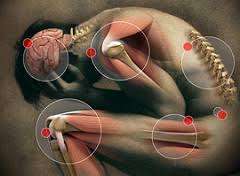
Fibromyalgia
Fibromyalgia derives from: “FIBROS” = soft tissues of the body, “MIOS” = muscles and “ALGIA” = pain. That is, “Musculoskeletal Pain”. To this definition we can add, “chronic, generalized and of unknown cause”. Fibromyalgia means “pain in the muscles, ligaments and tendons” (fibrous parts of the body).Fibromyalgia (FM) is a chronic pain syndrome without a fully recognised organic etiology and known to be characterized by generalized musculoskeletal pain, increased sensitivity to pain, stiffness, fatigue, a continuous sense of tiredness and non-restorative sleep, leaving sufferers with the feeling of not having rested during the night.
The causes of Fibromyalgia are not entirely clear and it is considered as an alteration in the central modulation of pain that is explained by the deficient concentration of various biogenic amines at the level of the central nervous system. Different studies suggest that patients with Fibromyalgia have a generalized state of amplification of pain. Fibromialgia patients complain of being in constant pain in the muscles accompanied by a burning sensation, although symptoms vary from patient to patient.
FM is frequent and is suffered by between 2 and 3% of the population, which represents between 400,000 and 1,200,000 people with Fibromyalgia in Spain. It is the third cause of consultation in rheumatology units (preceded by osteoarthritis and rheumatoid arthritis), 5.7% of internal medicine consultations and very frequent in physiotherapy rehabilitation units. It is more prevalent in women than in men (more than 75%), and can manifest itself at any age, even in children and adolescents with a maximum incidence in the age group between 20-60 years.
Fibromyalgia has recently been recognized by the World Health Organization but it has not formed part of the subjects taught in Medicine Faculties. It is difficult to diagnose being easily confused with other diseases because almost all its symptoms are common to other disorders without a known organic cause. It is common that before the definitive diagnosis is reached, different doctors from various specialties (digestive, heart, psychiatry …) have been consulted. Some people with fibromyalgia may be upset that some doctors do not consider it to be a true medical illness. Moreover, family members often end up doubting the veracity of the complaints of the patient, since analyzes and X-rays are normal.
The multiple discomforts cause uncertainty and anxiety for the sufferer, coupled with the fact that the process is often not identified, can in certain cases lead to depression. For this reason, patients with Fibromyalgia benefit greatly if they receive an adequate explanation about the nature of fibromyalgia, helping them understand their own limitations and make the appropriate lifestyle changes.
Causes
The pathophysiological basis for fibromyalgia is the hyperactivation of N-methyl-D-aspartate (NMDA) receptors, and substance P in the dorsal horn of the spinal cord. The synergism between substance P and NMDA receptors plays a fundamental role in the perpetuation of secondary hyperalgesia. Fibromyalgia is more than muscle pain, it is a type of general neuropathic pain.
The multidimensional features of Fibromyalgia can be explained by a pathological response to chronic stress and pain. Both nociceptive and analgesic sensitivity are genetically determined and condition functional vulnerabilities of the opioid, serotonergic, and human systems such as brain catecholamines.
Patients with FM show an abnormal sensitization to pain through the glutamate / aspartate system and substance P that lower the pain threshold and mediate allodynia (pain response to innocuous stimuli), hyperalgesia (nociceptive response intense to painful stimuli) and spontaneous pain, which are all perceived more intensely by women than by men.
Several neurobiological alterations have been detected in the nervous system of people with Fibromyalgia, such as:
- Lower pain threshold due to a functional abnormality in the CNS that according to some authors is due to a lower-than-normal regional cerebral blood flow.
- Brain biochemical alterations: a decrease in dynorphin, a brain endorphin (which would explain the sensitivity to pain) and an increase in substance P.
Symptomatology
The most important symptom of Fibromyalgia is pain. The person seeking the help of the doctor often complains that “everything hurts.” The pain is diffuse, affecting a large part of the body. On some occasions the pain has started in a generalized way, and on others in a certain area such as the neck, shoulder, lumbar spine, etc. and from there it has spread.
Fibromyalgia pain can be described by the sufferer as burning or discomfort. Sometimes muscle spasms can occur. Symptoms often vary based on time of day, activity level, weather changes, lack of sleep, or stress. Pain and stiffness are often worse in the morning, and muscles that are used repeatedly may hurt more. In addition to pain, fibromyalgia can cause generalized stiffness, especially when getting up in the morning and a feeling of swelling in the hands and feet. A diffuse tingling may also be noted, especially the hands.
Fatigue is another characteristic of Fibromyalgia that can last all day. This symptom can be mild in some patients and yet very severe in others. It is sometimes described as mental fatigue, with a feeling of general dejection, as if all energy has been drained and there is little desire to do normal tasks. Other times, patients refer to it as having their arms and legs stuck in concrete blocks.
70% of Fibromyalgia patients complain of having poor quality sleep (“I wake up more tired than I go to bed”), making the pain worse on days when they sleep poorly. Researchers find that fibromyalgia patients fall asleep easily, but their deep sleep is disrupted continually during the night.
People with Fibromyalgia suffer more frequently than non-sufferers anxiety and depression, as well as headaches, pains in menstruation, irritable bowel, chest pain, morning joint stiffness, cognitive or memory impairment, coughing or throbbing in the hands due to circulation disorders, muscle cramps, irritable bladder, sensation of swelling in the extremities, dizziness, dry eyes and mouth, changes in the prescription of glasses, and alterations in motor coordination. A notable deterioration of the functional capacity and quality of life of the patient is frequent.
Diagnosis
FM has been recognized by the World Health Organization, and today it is diagnosed based on the criteria described in 1990 by the American College of Rheumatology (criteria that are currently questioned as insufficient by some specialists):
- Generalized and chronic pain lasting more than 3 months and occurs in an entire hemibody, above or below the waist and in the entire axial skeleton, ruling out the existence of other pathologies.
- Pressure pain (approx. 4 Kg.) In at least 11 of the 18 tender points specifically located along the body: Occipital (insertion of suboccipitals), lower cervical (anterior face of intertransverse spaces C5- C7), trapezius (midpoint of superior border), supraspinatus (muscular origin above the spine of the scapula, near the medial border), chondrocostal junction of the second rib, lateral epicondyle (two cm distal to the epicondyles), gluteus (upper-outer quadrant of the buttocks, anterior fold of the thigh), greater trochanter (posterior to the trochanteric prominence), knee (medial fat pad, proximal to the joint line).
Psychological aspects
The emotional aspects of Chronic Pain are inseparable from the neurobiological, cognitive and behavioural aspects, The study of pain is only possible within the framework of a cognitive theory of emotion, which, proposes that emotional experiences result from central nervous system activation, from attributions (ideas and beliefs that the subject makes regarding their context) and the feedback effects of behavior.
The expression of FM differs from person to person, with individual differences in reactions to external, biological and psychological stimuli. Why does a patient get sick in one way and not another? All of this depends on what we call vulnerability. Vulnerability is an interdisciplinary concept that factors in the predisposing factors that trigger or maintain a disease and the psychological impact it has on each individual. As such, physical, psychological and sociological factors all need to be taken into account.
Treatment of Fibromyalgia
It would be false to say that fibromyalgia is an incurable disease that inexorably leads to total incapacity for work, or that there is nothing to do until a fully effective drug appears.
Despite the fact that huge improvements in the quality of life of the person with Fibromyalgia can be achieved, at the present time there is no treatment that produces the definitive cure of this disease.
The steps to follow for the correct treatment of Fibromyalgia are: firm diagnosis, explanation of the nature of the disease, education to avoid aggravating factors, treatment of associated psychological disorders, if any, behavior change, physical exercise, treatment of specific zones with massages, and the use of analgesics and other medications that increase tolerance to pain.
Regarding a firm diagnosis, it should be noted that knowing that you have this disease will save you a pilgrimage in search of diagnoses or treatments, it will reduce the anxiety caused by being ill without knowing why, and it will help to set specific goals.
Regarding the nature of the disease, it must be clarified that Fibromyalgia has nothing to do with cancer, it does not destroy the joints, and it does not cause irreversible injuries or deformities.
Avoid factors that aggravate symptoms. In general, if there are alterations when walking (one leg shorter than the other, inadequate footwear, …) they will have to be corrected with platforms, insoles or corrective shoes. Incorrect footwear leads to unnatural postures that force muscles and inevitably become painful. Seating both at home and at work needs to be adapted to prevent forcing muscles into unnatural positions. Avoid lifting or holding weights for which the muscles are not prepared.
Obesity overloads muscles and tendons which can aggravate Fibromyalgia, so losing weight is recommended for overweight FM sufferers.
Anxiety and Depression are not the cause of Fibromyalgia, but when they are associated with this disease, they make treatment more difficult. If you feel that you may be suffering from depression or anxiety, it is essential to get professional help from your family doctor, a psychiatrist or a psychologist.
Of all the measures that have been used in the treatment of Fibromyalgia, physical exercise and adequate muscle strength are undoubtedly the most effective. It is evident that exercise beyond the physical capacity of the individual worsens the pain, which increases the likelihood of abandon it. That is why this muscular strength needs to be achieved little by little. Stroll, walk on a treadmill, or swim in a heated pool are all go ways of easing yourself into a physical exercise routine. If at all possible is better to form part of a group or association as this will help motivate and an exercise routine can also become an event for socialising.
Massage, muscle stretching exercises, applied local heat, and some types of electrotherapy can offer relief. Local injections of painful points with local anesthetics, especially if followed by a local massage, are of great help for intense localized pain. Painkillers or pain relievers can help reduce pain, but their efficiency is limited and should never be used as a “stand alone” treatment. There is an alternative group of drugs, which act on other mechanisms, increasing serotonin levels, and which improve symptoms in a good number of patients. Of the many treatments used to date, tricyclic antidepressants, cyclobenzaprine along with local anesthetics have demonstrated good pharmacological effectiveness.
Future of FM treatment
Regarding the prognosis, long-term studies on Fibromyalgia have shown that it is a chronic disease, but the symptoms vary in frequency and intensity. The future for treating this disease is promising, as research on Fibromyalgia is progressing rapidly. Knowledge of the physical and chemical mechanisms that occur in our body in response to external stimuli, such as stress, are especially relevant and will continue to increase our efficacy in treating Fibromyalgia.
Leave a reply





Leave a reply